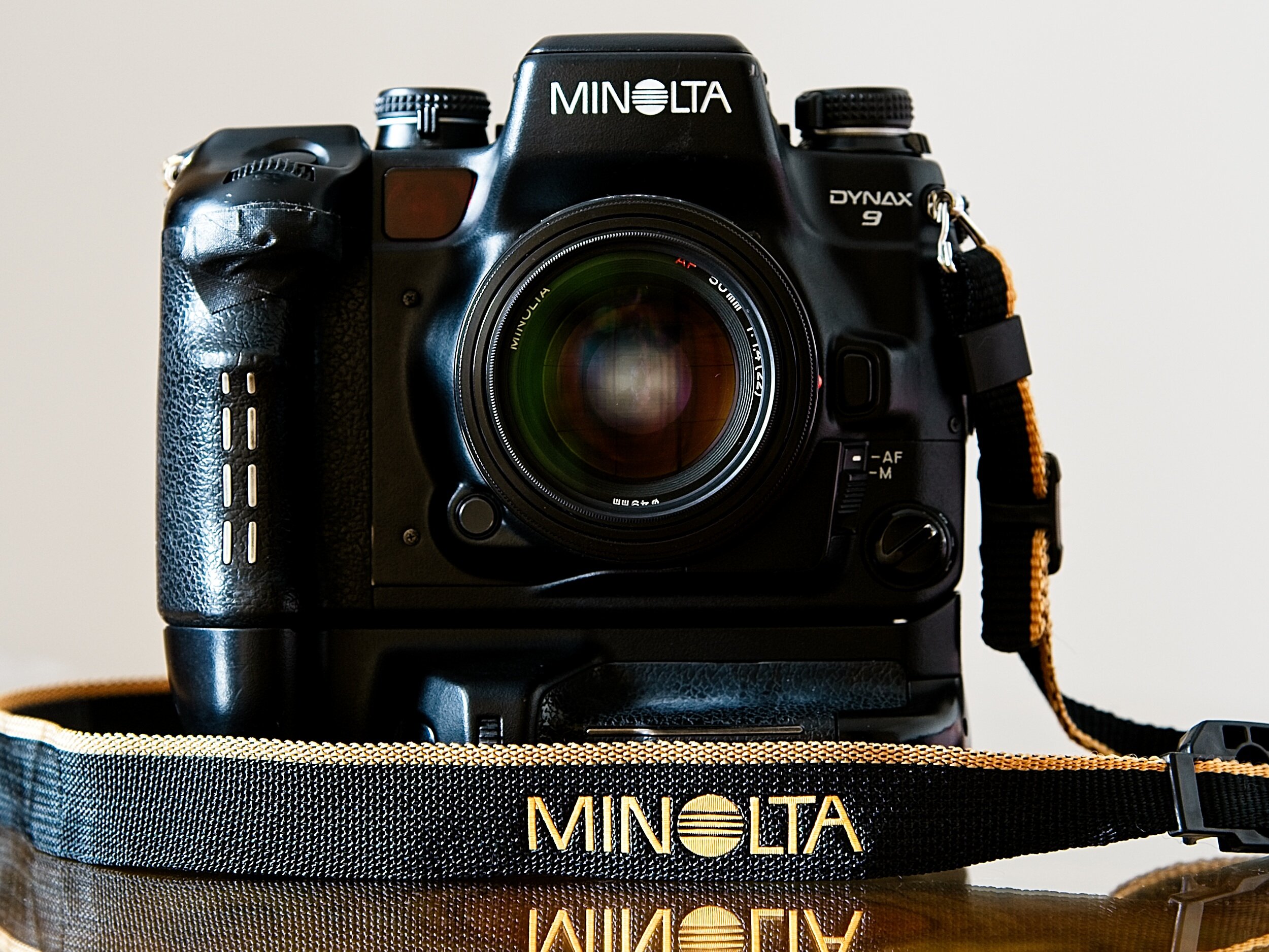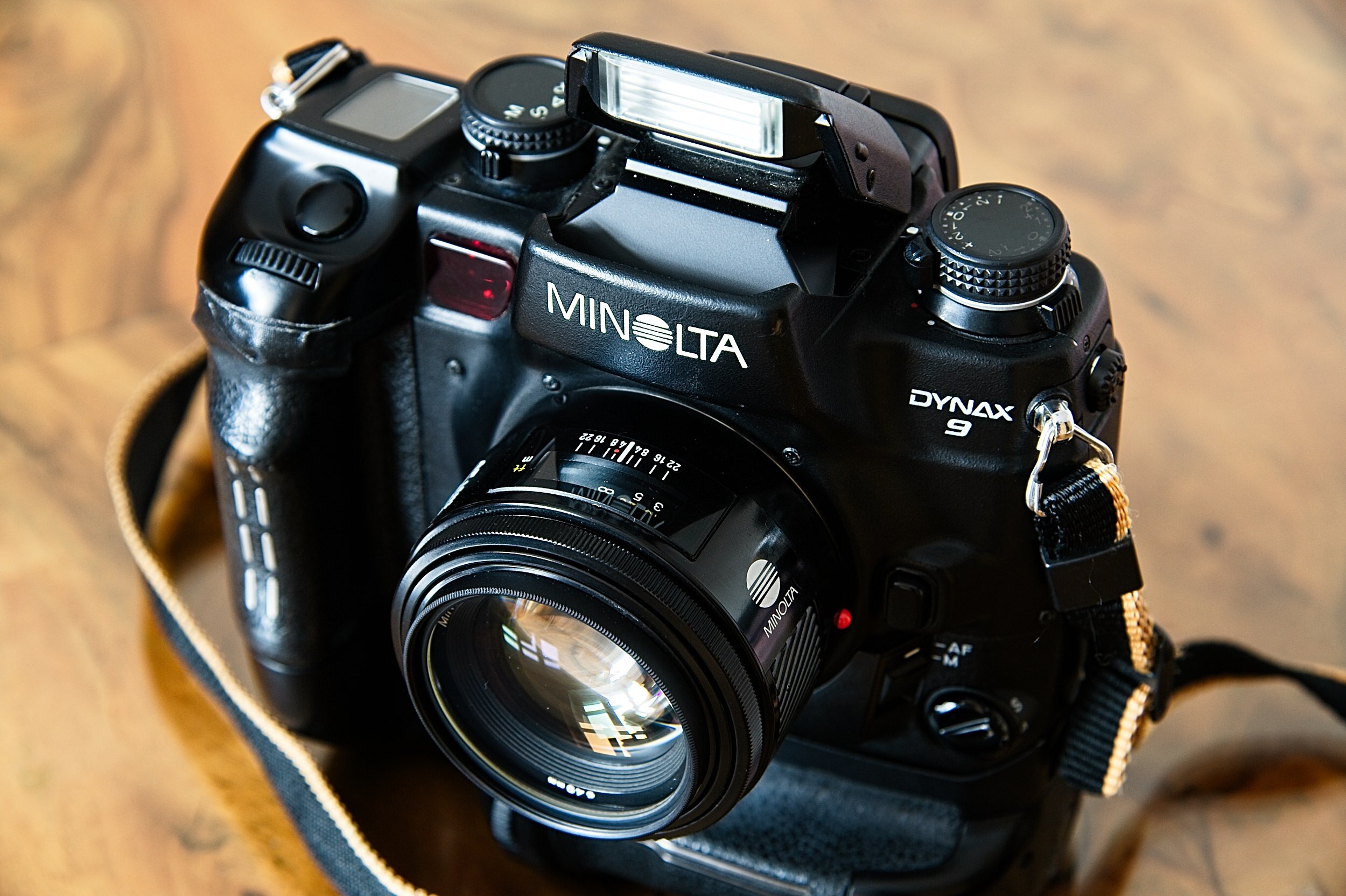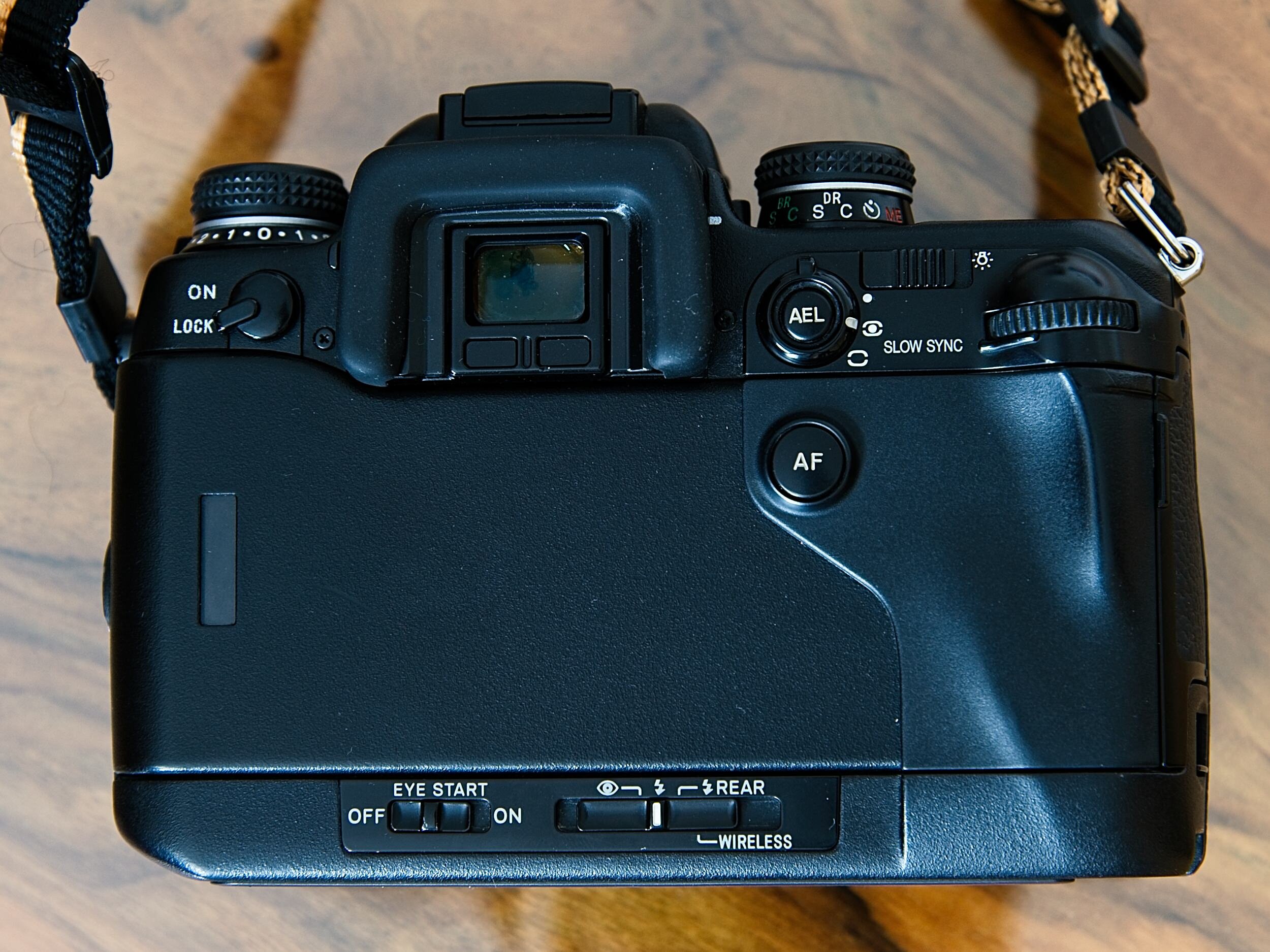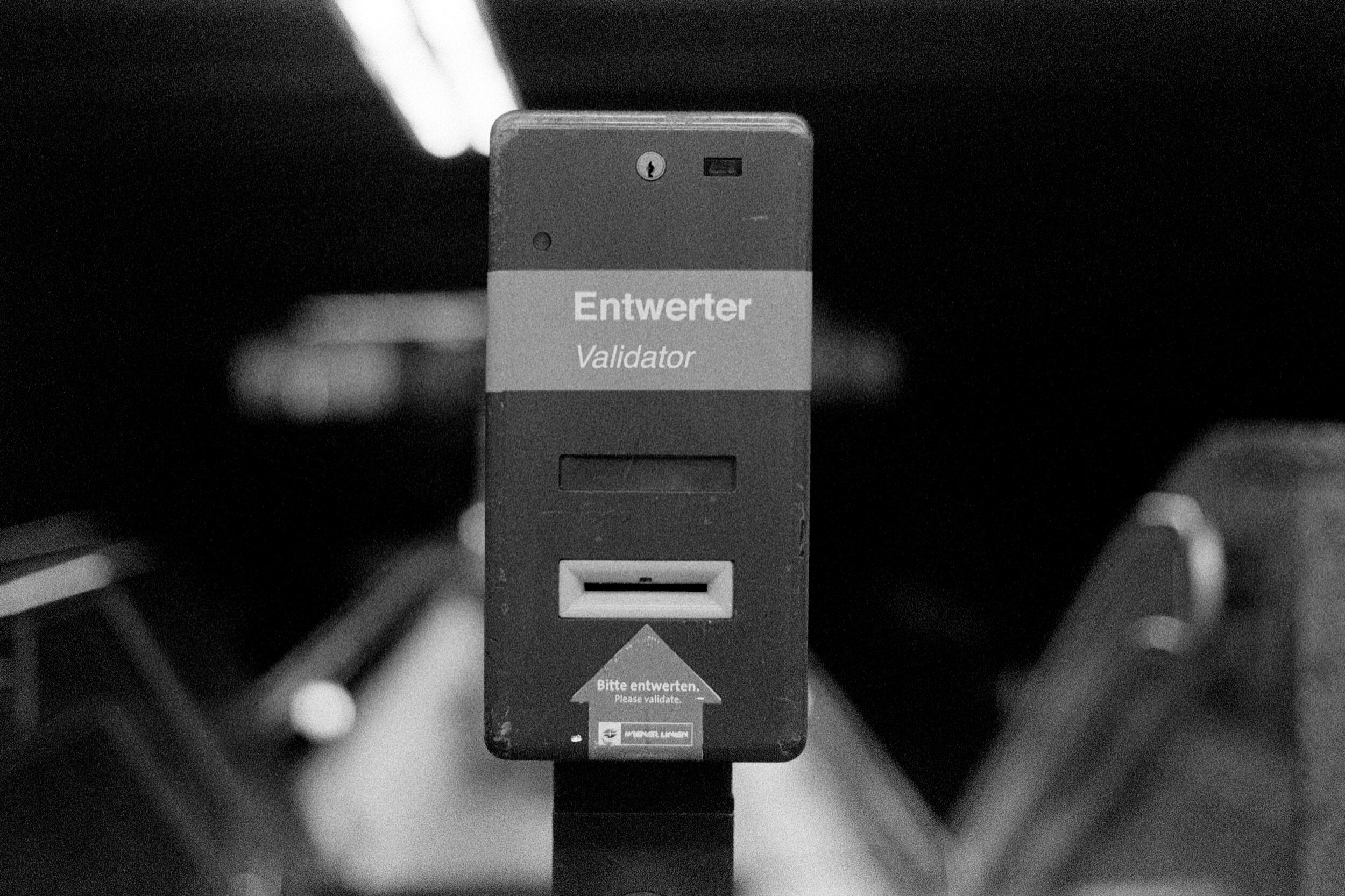Minolta Maxxum 9 / Dynax 9 / Alpha 9
Introduction
Minolta Dynax 9
It is the year 1998, Cologne, Photokina: To celebrate 70 years Minolta, the famous camera manufacturer introduces its new high-end 35mm flagship camera: The Minolta Dynax 9, also known as the Maxxum 9 (USA) or α-9 (Japan). It is a camera of superlatives: Fast autofocus, advanced metering, the fastest mechanical shutter of any camera, all in a fully weather sealed compact pro body.
It is the year 2006: Camera giant Minolta announces to exit the photography business. The 9 remains the finest Minolta model, there will never be a successor bearing the name Minolta.
The present: Minolta’s engineering marvel is in my hands, and it is time to share my passion for this camera.
Review
In my initial draft of this review I tried to mention every noteworthy feature of the Minolta 9 and how it might be useful for ones photography. As I always found one additional outstanding feature worth mentioning, the text got longer and longer and started to feel like spec sheet. So I decided to scrap everything and switch gears. Instead, I want to convey how it feels to create with the Minolta Dynax 9. But before I do that, here are some of the most outstanding features I just have to list in order to give you an impression how advanced the camera is:
Minolta Dynax 9 top view
Fully weather sealed stainless steel body with UV-hardened polymer body
Minolta A mount
Weight fully loaded about 1 kg
100% coverage viewfinder
Top shutter speed 1/12.000 of a second (world record until today)
HSS Flash with proprietary Minolta flash depending on the model ~1/8.000 of a second
AF-System with 3 CCD sensors including one crosspoint in the middle
Advanced exposure metering using a honeycomb pattern
Dedicated control dials for every relevant camera function
Exposure data is stored to be transferred to a computer with something like the Meta35.
Having said that, you can see that this camera competes with the most advanced 35mm film cameras. It is on par if not better than the Nikon F5 and I would even go as far as to say that in overall performance it is only trumped by the one and only Nikon F6 (which I bought recently).
Build Quality and Design
The camera is very comfortable to hold and the all controls are conveniently placed. Unfortunately, the rubber grip on all regular Minolta 9 cameras I ever saw is in a state of degradation. Mine even started to fall apart. I tried various rubber preservatives but none could stop the process. So I ended up gluing the pieces together with a special adhesive and further protecting them with tape, as there are of course no spare grips available anymore. You can also replace the rubber with grip tape, but you’ll end up blocking the metal contacts in the front. They are used for the auto start up function, which then would no longer work.
Dynax 9 control dials & custom function buttons
While previous Minolta models had a more button-centric control concept, the designers equipped the 9 with numerous dials made out of high density plastic. Besides front and rear command dials which work just like on any modern DSLR, there are dedicated dials for exposure compensation, flash exposure compensation, metering modes (spot, centre-weighted, honeycomb), AF modes, drive modes and exposure modes (P,A,S,M). A small LCD on top indicates shutter speed and aperture as well as other information depending on selected sub-functions (e.g. changing the ISO or bracketing mode). This amount of direct control is unique and can only be found on the Minolta 9. I don’t think this is a huge advantage over the Nikon hold-button-rotate-dial approach, but consider that you can check almost all your settings without looking at a display.
Talking about displays, it is important to note that the LCD displays in the finder are not illuminated sufficiently. In bright conditions, it is impossible to see the information. You have to rely on the shoulder LCD display.
The integrated retractable flash can serve as a commander for Minolta’s then state of the art flash system.
The optional VC-9 handgrip allows the use 4 AA batteries instead of two CR123A. Ergonomically, the handgrip is outstanding. Other than most handgrips, it is designed so that there is almost no difference in handling between landscape and portrait orientation. It is a worthy accessory to get. When attaching the battery grip, you do not have to detach the battery cover or remove rubber flaps. Everything retracts into the body, so you can’t lose any small parts. Small details like these show the amount of thought that went into the design.
The Dynax 9 has an integrated flash
User Experience
The Minolta Maxxum 9 just works. It is a professional-grade camera that can handle any relevant photographic scenario, as long as you are aware of the 9’s strengths and weaknesses.
Auto Focus
I found the AF to be very accurate and I did not experience back- or front focusing issues with my camera. When using the central cross-point, the camera focuses almost as quickly as a modern DSLR. Things can get a little bit slower with the two non-cross-type AF points. Even in very dark conditions it worked reliably, albeit slower. When I occasionally shot in C-AF mode tracking slow moving subjects, it performed reliably with apertures around f/8. All in all, the system is very similar to the one in the Olympus E-1. Fun fact: The cross-type sensor was so good that it was also used in the Hasselblad H1 in 2002 - great times when Minolta was still the undisputed king of AF.
Minolta Maxxum 9, 28-135mm f/4-4.5 & 5400 HS Flash
Exposure Metering & Flash Exposure Metering
The honeycomb pattern metering is very similar to a matrix metering system. Applying fuzzy logic, the system very rarely fails. I found it to struggle in backlit situations, underexposing the film sometimes by more than one stop. But now you know, so just use spot metering or the exposure compensation dial.
The system also reliable calculates the flash exposure - even spot flash exposure - and the manual lists many different ways to make full use of the many possibilities when using remote controlled Minolta flashes.
In Use
To be honest, you have to try the Minolta Dynax 9 yourself and experience it. This camera is greater than the sum of its parts, and even in 2020 it feels like a sophisticated high-end camera. Many small details lead to to a great experience.
For example, when the camera is turned off, it automatically sets the focus to infinity so that the lens barrels of the lenses retract as much as possible. This saves space in your camera bag and reduces the risk of bumping the lens into things.
Considering its capabilities, it is a quite small camera. Combine that with the easy camera controls and you got yourself not only a professional tool but also an everyday companion. I even brought it to a birthday party - loaded with Ilford Delta3200 & a 50mm f/1.4 - and everyone was instantly able to use it.
Minolta Maxxum 9 rear view - dedicated AF-button
One of my initial objections was the AF system - will it be reliable and fast enough? The answer is yes, it can actually speed up your workflow when you don’t have to fiddle with multiple AF-points and AF-modes no one needs in 99% of shooting scenarios. Just focus, recompose, done! And yes, there is a dedicated button for those back-button AF enthusiasts.
The shutter sound is refined and there is no out-of-the-ordinary mirror slap noticeable.
One annoyance in everyday use is the non-standard flash shoe. Theoretically, you could use an adaptor. But, it is an abominably unstable to mount a flash on top of a plastic adapter and the Minolta 9 is very picky - it does not work with every Sony “hot shoe to standard” adapter you can find out there, sometimes even not triggering the mounted flash in manual mode.
Oh, did I mention it does frame-accurate mid-roll film reloading / rewinding?
Other Considerations
Reliability
My Minolta 9 never failed in any way. No issues with the automatic film transport, no mechanical or electronic hiccups or anything. Although when there is a problem with it, it might be difficult to get the camera repaired. MInolta rated the shutter to at least 100.000 actuations, so it should theoretically last long enough for a decade or more of shooting film.
SSM-Upgrade
Most Minolta A-mount lenses use the focusing motor of the Dynax 9. However, later versions as well as the Sony A-mount lenses use SSMs in the lenses. Minolta once offered to upgrade the Dynax 9 to use communicate with these SSM-lenses, but not all users sent their cameras in. According to my knowledge, you can’t tell whether the upgrade was performed or not without trying a SSM-lens or checking the service manual.
Pricing & Availability
In 2020, the Minolta Maxxum 9 retails for about 300 € used in very good condition. Availability is a mixed bag: A single Minolta 9 is sometimes up for sale for a very long time, but fewer and fewer show up in total. Especially the minty ones seem to have gotten quite rare in recent years. So don’t wait too long if you see one in good condition.
Accessories
Some accessories are hard to get, and it can take some time until you find something specific like a Minolta Program 5400 HS flash in good working condition.
Minolta angle finder with 1x to 2x magnification
Minolta remote trigger with proprietary connector
Minolta AF Lenses
I only have two lenses for my 9: The Minolta 50mm f/1.4 AF and the Minolta 28-135mm f/4-4.5 AF.
Minolta AF 28-135mm f/4-4.5 & 50mm f/1.4 collapsed
Minolta AF 28-135mm f/4-4.5 & 50mm f/1.4 extended
Optically, both lenses are very good to excellent.
Especially the 28-135mm is a surprise - I shot a technically demanding commissioned work for artist Raffaela Bielesch on slide film, and the results were very satisfying I’d say.
Also, don’t be fooled by the plastic exterior and 80s/90s vibe. The build quality is excellent, and the interior of the 28-135mm is completely made of metal.
Pricing & Availability
As the Minolta lenses are also adaptable to recent Sony A-Mount cameras and Alpha mirrorless models, some types have become quite rare and the overall price for each lens is quite high compared to used Nikon AF-lenses. Even something like the 135mm f/2.8 (which is a great lens!) can set you back 300 €.
When buying an “inexpensive” pro body like the 9, you have to take this into account.
As an architectural photographer keep in mind that there is only one 35mm f/2.8 A-mount shift lens available.
Sample Gallery
The sample images were all shot with the Minolta 50mm f/1.4 AF on Ilford Delta 3200 and Bergger Pancro 400.
Verdict
The Minolta Alpha 9 is a compelling choice if you look for a pro-grade 35mm camera with all the bells and whistles you’ll ever need. It has a unique design, great ergonomics and a tragic “I Am Legend” origin story. It is truly one of the greatest if not the greatest Minolta camera of all times.
Compared to the competition, there is only one camera that clearly outperforms the Minolta 9 in every way (and that I have used, never tried the Canon AF cameras) - and that is the Nikon F6. But this beast is significantly more expensive.
A real dealbreaker might be the lens ecosystem. Limited availability and pricing can be a show-stopper - so make sure you can get all the lenses you’ll need for your photography.
Or just get a 9 with a cheap, yet excellent 50mm AF (f/1.8 or f/1.4) and enjoy the experience of shooting one of the finest 35mm SLRs ever produced.
Minolta is dead, but hey - long live the Alpha 9!
Another Minolta Maxxum 9 Review…
by Alex Luyckx - check it out!
















